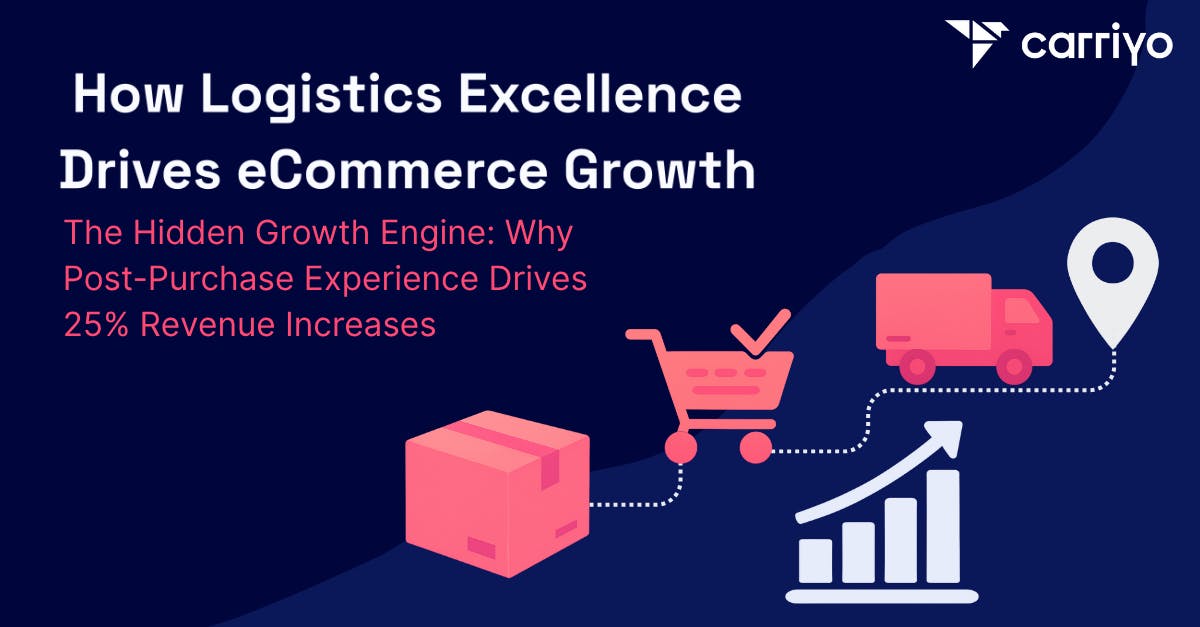
Last Mile Innovation
Jul 31, 2025
ARTICLE
The Hidden Growth Engine: Why Post-Purchase Experience Drives 25% Revenue Increases
In today's competitive eCommerce landscape, shipping and logistics have evolved from operational necessities to powerful growth engines. Companies optimizing their post-purchase experience see 25% increases in revenue through improved customer retention, while advanced logistics strategies deliver 40-45% productivity gains through automation and smart carrier management.
With global eCommerce reaching $6.09 trillion in 2024, the competitive advantage increasingly lies in delivering exceptional shipping experiences that transform one-time buyers into loyal customers. 86% of customers base their repeat purchase decisions on post-purchase experience, making logistics optimization a strategic investment for sustainable growth.
The new eCommerce growth drivers
The eCommerce landscape has fundamentally shifted, creating new opportunities for retailers who understand how to leverage these trends for competitive advantage.
Mobile commerce revolution
Mobile commerce dominance continues, expected to reach 62% of all eCommerce sales by 2027. Mobile apps show 3x higher conversion rates than mobile websites, with 79% of landing page visits now coming from mobile devices.
This shift demands mobile-optimized fulfillment strategies:
- Instant gratification expectations: Mobile users expect same-day or next-day delivery options
- Location-based services: GPS-enabled apps create opportunities for store pickup and local delivery
- Push notification engagement: Mobile apps enable real-time delivery updates that drive 40% higher engagement rates
- One-click reordering: Mobile interfaces simplify repeat purchases, with mobile users showing 27% higher lifetime value
The logistics implication: Retailers need fulfillment systems that support mobile-first customer journeys, from flexible delivery options to real-time tracking optimized for mobile screens.
Elevated customer expectations
Customer expectations for delivery speed and transparency have intensified. 89% of consumers rate package tracking ability as important, while 85% won't shop again after a poor delivery experience. Real-time visibility has become non-negotiable for competitive advantage.
Modern consumers expect:
- Proactive communication: 73% want delivery updates without having to request them
- Delivery flexibility: 55% prefer choosing specific delivery time windows
- Easy returns: 92% will buy again if returns are easy, with 30% expecting free return shipping
- Sustainability options: 73% are willing to pay more for sustainable shipping options
The Amazon effect has created universal expectations for:
- Two-day delivery as standard (not premium)
- Real-time tracking with precise delivery windows
- Easy modification of delivery preferences
- Seamless returns processing
Social commerce explosion
Social commerce reached $945.92 billion in 2023, growing at 30% CAGR. These platforms create opportunities to integrate shipping excellence directly into social selling strategies.
Platform-specific opportunities:
- TikTok Shop: Accounts for over 1% of UK online purchases, with users expecting fast fulfillment to maintain purchasing momentum
- Instagram Shopping: Visual-first audience values premium unboxing experiences and branded packaging
- Facebook Marketplace: Local commerce opportunities for same-day delivery and pickup options
- Pinterest Shopping: Planning-oriented users willing to pay premium for reliable delivery timing
Social selling logistics requirements:
- Impulse purchase fulfillment: Quick processing to capitalize on social media-driven buying decisions
- Influencer collaboration: Special packaging and expedited shipping for influencer partnerships
- User-generated content: Exceptional delivery experiences that encourage social sharing
Omnichannel fulfillment imperative
Omnichannel fulfillment drives customer loyalty. Retailers offering buy-online-pickup-in-store (BOPIS), ship-from-store, and flexible return options see 20% higher customer retention rates compared to single-channel operations.
Key omnichannel strategies:
Buy Online, Pick Up In Store (BOPIS):
- 67% of consumers have used BOPIS services
- Increases basket size by 30% through in-store add-on purchases
- Reduces shipping costs while driving store traffic
Ship from Store:
- Reduces delivery times by 1-2 days compared to warehouse fulfillment
- Optimizes inventory across all locations
- Turns retail locations into micro-fulfillment centers
Curbside Pickup:
- Grew 208% during pandemic and maintains popularity
- Appeals to convenience-focused customers
- Reduces operational costs compared to home delivery
Flexible Returns:
- Return to any store location regardless of purchase channel
- Instant refunds or exchanges to improve customer satisfaction
- Opportunity for staff to address concerns and drive future purchases
Personalization at scale
Personalized experiences drive 19% higher revenue compared to generic approaches. Customers expect tailored experiences throughout their journey, including shipping and delivery.
Personalization opportunities in logistics:
- Delivery preferences: Remember preferred delivery times, locations, and carriers
- Communication channels: Customer choice of SMS, email, or app notifications
- Product recommendations: Relevant suggestions in tracking pages and delivery confirmations
- Loyalty integration: Special shipping perks for VIP customers and program members
Data-driven insights enable:
- Predictive delivery preferences based on past behavior
- Dynamic pricing for premium delivery options
- Seasonal adjustment of shipping options and timing
- Geographic optimization based on local customer preferences
Sustainability as competitive advantage
Environmental consciousness influences 73% of purchasing decisions, with younger consumers especially valuing sustainable practices.
Sustainable logistics strategies:
- Carbon-neutral shipping: Offset programs that appeal to environmentally conscious consumers
- Packaging optimization: Right-sized packaging and eco-friendly materials
- Consolidated shipping: Encouraging bulk orders through delivery incentives
- Local fulfillment: Reduced transportation distances through distributed inventory
Marketing advantages:
- Sustainability messaging in delivery communications
- Transparency about environmental impact reduction
- Partnership with eco-friendly carriers and initiatives
- Customer education about sustainable shipping choices
How Carriyo supports these trends
Carriyo's platform directly addresses these growth drivers through:
Mobile-First Operations: The Ship from Store app empowers retail staff to fulfill orders directly from mobile devices, supporting seamless omnichannel experiences that meet mobile commerce demands.
Real-Time Visibility & Proactive Communication: Automated SMS, email, and WhatsApp notifications keep customers informed throughout delivery, while branded tracking pages maintain engagement within your brand ecosystem instead of generic carrier sites.
Social Commerce Integration: API-first architecture integrates seamlessly with social commerce platforms, ensuring orders from TikTok Shop, Instagram, or other channels receive the same optimized shipping experience as traditional eCommerce orders.
Omnichannel Fulfillment: Support ship-from-store operations, multiple carriers, and flexible delivery options all from one platform. Enable BOPIS, local delivery, and seamless returns to meet diverse customer preferences.
Key metrics that matter
Supply chain optimization delivers 277% ROI, vastly outperforming other business functions. The most critical metrics include:
- 98%+ on-time delivery rates (best-in-class standard)
- 99.89% order accuracy to maintain customer confidence
- Perfect order rate encompassing damage-free, on-time, accurate shipments
These metrics directly impact growth: 85% of consumers won't shop again after poor delivery, while loyal customers spend 30% more than new ones. Companies with superior supply chains consistently outperform competitors in revenue generation.
Technology solutions driving growth
Autonomous Mobile Robots improve fulfillment speed by 200-300% while reducing picker walking time by 60%. Multi-carrier platforms like ShipStation help customers scale operations 40X while saving millions through automated rate shopping.
The logistics API market projects $5.23 billion growth with platforms like Carriyo processing 100 bookings per second. Most retailers achieve ROI within 3-6 months from shipping software implementations.
Key technologies include:
- Multi-carrier automation for 10-25% cost reductions
- Real-time tracking (89% of consumers rate as important)
- Branded tracking pages with 89% open rates vs 20% for regular marketing
- AI-driven personalization achieving 19% conversion rates vs 2.9% without
How Carriyo accelerates growth
Carriyo's comprehensive platform addresses every aspect of logistics optimization:
Automated Dispatch & Multi-Carrier Management: Connect with 100+ carriers instantly, with automatic shipment assignment based on cost, speed, and reliability. Reduce manual operations by 80% while accessing negotiated rates across regions.
Branded Customer Experience: Transform generic tracking into revenue-driving touchpoints. Branded tracking pages maintain customers in your ecosystem while enabling cross-selling and loyalty program enrollment.
Real-Time Visibility & Analytics: Monitor shipments across all carriers from one dashboard. Service level monitoring prevents delays while customer feedback loops identify improvement opportunities.
Ship from Store: Enable omnichannel fulfillment with mobile apps for store staff. Process local deliveries and reduce shipping costs while getting closer to customers.
Companies using Carriyo report 30% reduction in customer service calls, 200% increase in shipping volume capacity, and 95% delivery rate improvements within the first month.
Conclusion: From cost center to growth engine
Logistics optimization represents a fundamental shift from operational efficiency to strategic competitive advantage. The retailers thriving in 2025 recognize shipping not as a cost to minimize, but as a growth engine to optimize.
The convergence of AI-driven automation, multi-carrier strategies, and branded customer experiences creates unprecedented opportunities for differentiation. Companies implementing comprehensive shipping strategies achieve measurable improvements in customer retention, operational efficiency, and revenue growth that compound over time.
Success requires treating logistics as a customer experience differentiator. Through strategic technology investments, real-time visibility, and branded touchpoints, leading retailers transform shipping from a necessary expense into a powerful driver of customer loyalty and sustainable business growth.
01

Joao Vieira
CRO at CARRIYO
Inside the City: How Urban Freight and Micro-Distribution Are Redefining the Last Mile
Oct 7, 2025 - 4min read
02

Faisel Azeez
Co-Founder & CTO
Connected Fleets: How Telematics and Data Are Powering the Next Generation of Logistics
Oct 6, 2025 - 5min read
03

Joao Vieira
CRO at CARRIYO
Last Mile, First Priority: Why Experience Matters More Than Speed
Oct 2, 2025 - 5min read
Automate shipping operations and elevate post-purchase customer experience
We're trusted by

